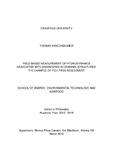JavaScript is disabled for your browser. Some features of this site may not work without it.
| dc.contributor.advisor | Rivas Casado, Monica | |
| dc.contributor.advisor | Blackburn, Kim | |
| dc.contributor.advisor | Gill, A. B. | |
| dc.contributor.author | Kriechbaumer, Thomas | |
| dc.date.accessioned | 2017-01-19T16:22:01Z | |
| dc.date.available | 2017-01-19T16:22:01Z | |
| dc.date.issued | 2016-03 | |
| dc.identifier.uri | http://dspace.lib.cranfield.ac.uk/handle/1826/11315 | |
| dc.description.abstract | The construction of fish passes has been a longstanding measure to improve river ecosystem status by ensuring the passability of weirs, dams and other in- channel structures for migratory fish. Many fish passes have a low biological effectiveness because of unsuitable hydrodynamic conditions hindering fish to rapidly detect the pass entrance. There has been a need for techniques to quantify the hydrodynamics surrounding fish pass entrances in order to identify those passes that require enhancement and to improve the design of new passes. This PhD thesis presents the development of a methodology for the rapid, spatially continuous quantification of near-pass hydrodynamics in the field. The methodology involves moving-vessel Acoustic Doppler Current Profiler (ADCP) measurements in order to quantify the 3-dimensional water velocity distribution around fish pass entrances. The approach presented in this thesis is novel because it integrates a set of techniques to make ADCP data robust against errors associated with the environmental conditions near engineered in-channel structures. These techniques provide solutions to (i) ADCP compass errors from magnetic interference, (ii) bias in water velocity data caused by spatial flow heterogeneity, (iii) the accurate ADCP positioning in locales with constrained line of sight to navigation satellites, and (iv) the accurate and cost-effective sensor deployment following pre-defined sampling strategies. The effectiveness and transferability of the methodology were evaluated at three fish pass sites covering conditions of low, medium and high discharge. The methodology outputs enabled a detailed quantitative characterisation of the fish pass attraction flow and its interaction with other hydrodynamic features. The outputs are suitable to formulate novel indicators of hydrodynamic fish pass attractiveness and they revealed the need to refine traditional fish pass design guidelines. | en_UK |
| dc.publisher | Cranfield University | en_UK |
| dc.rights | © Cranfield University, 2016. All rights reserved. No part of this publication may be reproduced without the written permission of the copyright holder. | en_UK |
| dc.subject | Doppler Current Profiler | en_UK |
| dc.subject | attraction flow | en_UK |
| dc.subject | eco-hydraulics | en_UK |
| dc.subject | fish pass attractiveness | en_UK |
| dc.subject | flow measurement | en_UK |
| dc.subject | Global Navigation Satellite System | en_UK |
| dc.subject | radio-control boat | en_UK |
| dc.subject | river monitoring | en_UK |
| dc.subject | stereo vision | en_UK |
| dc.subject | Total Station | en_UK |
| dc.subject | visual odometry | en_UK |
| dc.title | Field-based measurement of hydrodynamics associated with engineered in-channel structures: the example of fish pass assessment | en_UK |
| dc.type | Thesis or dissertation | en_UK |
| dc.type.qualificationlevel | Doctoral | en_UK |
| dc.type.qualificationname | PhD | en_UK |
